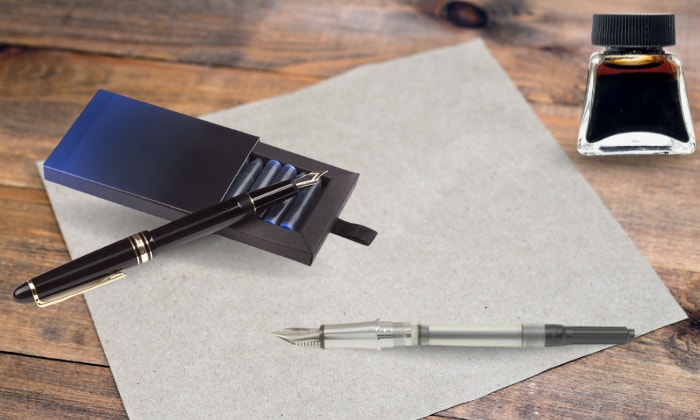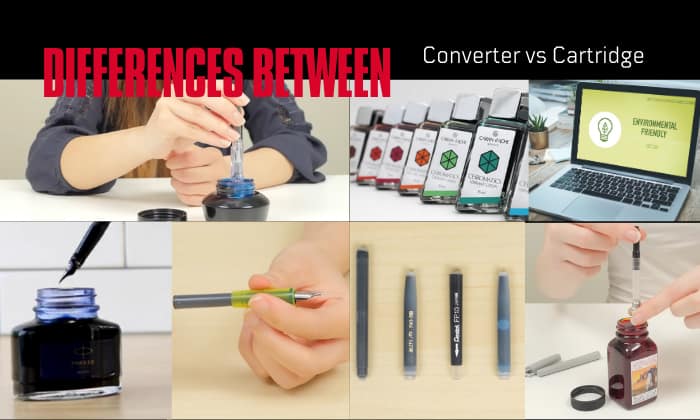Fountain pens provide a unique writing experience with cartridges and converters, which are two options to fill the ink and keep your pen working. Determining the optimal filling system can indeed be challenging if you are new.
Many people find converters better than cartridges because of the vast array of ink colors for customization, their eco-friendliness, and cost-effectiveness.
In this fountain pen cartridge vs converter comparison, we’ll elucidate the differences, pros, and cons of both filling systems. By the end of this discussion, you can choose which one is the most suitable for your specific needs and preferences. Let’s keep reading to find out!
Table of Contents
Converter and Cartridge Overview
What is a fountain pen cartridge?
A fountain pen cartridge is a small, disposable cylinder filled with fountain pen ink. Changing fountain pen ink cartridges is easy. You just need to insert the ink cartridge into the pens when they run out of ink.
Disposable cartridges offer a convenient and mess-free way to refill a fountain pen, especially useful for writing on the go.
They also come in many sizes and shapes to suit different pen models, with cartridge sizes ranging from 38.5 mm (Standard International Short) to 76mm (Parker). The short size is compact and compatible with many pens, while the long size holds more ink for extended writing.
What is a fountain pen converter?
A fountain pen converter is a reservoir that fits into a fountain pen in place of a cartridge. It allows you to use a fountain pen ink bottle to refill your pen.
There are several fountain pen converter types, with the three most popular including:
- Piston converters: This is the most common converter for fountain pen. They operate using a twist mechanism. By twisting the end, the user creates a vacuum that sucks the ink into the reservoir. It’s straightforward and allows for fine control of ink intake.
- Squeeze converters: work by applying pressure to a sac, which then creates a vacuum to draw ink when released. They’re simple but offer less control over ink volume.
- Push-button converters: function through a button mechanism, which, when pressed, creates a vacuum that draws up ink. They provide a quick and easy refill process.
Fountain Pen Converter vs Cartridge Differences
Let’s make clear the differences between an ink converter and cartridges by comparing the following features.
- Easy to use
Cartridges are extremely easy to use, requiring you to simply insert them into the pen for writing.
On the other hand, converters require filling from an ink bottle, which might need some practice and finesse.
- The wide array of ink colors
Cartridges are typically limited to the colors offered by the pen’s manufacturer.
Conversely, converters, being refillable with any bottled ink, offer a virtually limitless array of colors, allowing you to fully customize your writing experience.
- Environmentally friendly
Fountain pen cartridges are less environmentally friendly. Once a cartridge is empty, it’s discarded and ends up in the waste stream, contributing to landfill and potential plastic pollution if not properly recycled.
Converters are designed for reuse. So instead of discarding a used-up unit, you simply refill it with ink from a bottle. This characteristic makes converters a more sustainable choice, as they result in less waste over time.
- Compatibility
Some pens use proprietary cartridges that are unique to a specific brand. This can limit your options if you are using a pen that does not adhere to standard cartridge sizes. However, many pens accept Standard International cartridges, which are widely available and fit a variety of pen brands.
Converters also vary in compatibility like cartridges. It’s crucial to ensure the converter is suitable for your pen model. You can check a compatibility chart before purchasing to see which brands use standard designs. Edison and Conklin fall under this category, for example, while Faber-Castell and Parker have proprietary ink converters.
- Convenience
Pen cartridges offer excellent convenience, especially for on-the-go usage. They’re small, easily transportable, and require no extra tools or bottles of ink.
Converters, however, require a certain setting for a refill, making them less convenient for mobile use.
- Capacity
Cartridges generally hold less ink compared to converters, although the difference is marginal (around 0.1 ml only).
Some converters may hold a significant amount of ink, reducing the frequency of refills.
- Experiencing the full ritual of fountain pen usage
For some, the process of manually filling their pens with ink is a crucial part of the fountain pen experience. Cartridges don’t offer this, but converters do, adding a personal and traditional touch to using your fountain pen.
Price – Which is More Affordable?
Consider the Monteverde International Size Cartridges, sold in a pack of 6 for $6.75. This amounts to $1.125 per cartridge. Each cartridge holds less than 1ml of ink and is single-use.
On the other hand, a Waterman 50ml Ink Bottle is about $12.03. This bottled ink can be used with a converter to refill your fountain pen.
When you compare the two, the cost differences become apparent. The cartridges offer about 6ml of ink for $6.75, while the ink bottle provides 50ml for $12.03.
To visualize it further, with the $12 you spent on the bottled ink, you’d be able to fill your converter approximately 50 times (since each converter fill might use around 1ml). In contrast, spending the same $12 on cartridges (nearly 2 packs of Monteverde International Size Cartridges) would only provide around 10 to 12 fills.
Therefore, while the initial cost of an ink bottle is higher, it provides significantly more uses, making it a more cost-effective option in the long run.
Pros and Cons
1. Cartridges
- Straightforward to use
- Convenient for on-the-go use
- Generally mess-free
- Wide availability
- Limited ink colors
- Less environmentally friendly
- One-time-use design
- Can be more costly over time
- Hold less ink
2. Converters
- Endless supply of ink colors
- More environmentally friendly
- More cost-effective
- Enables experiencing the full ritual of fountain pen usage
- Can be more complex to use
- Potentially messy during ink refill
- Less convenient for travel or on-the-go use
Which is Better? Why?
Whether a fountain pen cartridge or converter is better largely depends on individual preferences and circumstances.
However, many people often lean towards converters. This is because the cartridge converter allows them to choose from a vast range of bottled inks, enabling them to customize their writing experience fully.
Over the long term, buying bottled ink tends to be cheaper than cartridges. Lastly, converters are reusable, which aligns with the increasing global emphasis on sustainability and reducing waste.
Choosing Between Cartridges and Converters
To decide which one makes the most sense to you, let’s think about your preferences and circumstances.
If you prioritize convenience, simplicity, and portability, a cartridge ink pen may be the superior choice.
However, if you are looking for a refillable fountain pen no cartridge with a wide range of ink colors, plus cost-effectiveness over time, then a converter would be the better option.
Conclusion
The debate on the fountain pen cartridge vs converter is about understanding your needs and making the choice that best aligns with your fountain pen experience.
Cartridges offer convenience and ease, while converters provide an eco-friendly choice with access to a wide range of colors, ink choices, and potential cost savings.
Hopefully, you can find the best option after this discussion!

Art has always been a part of my life; it influences my upbringing and later my career choice. For me, it is always a part of my parenting technique. So for whichever purpose that you come to art, you can start here with us.







